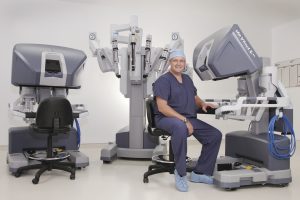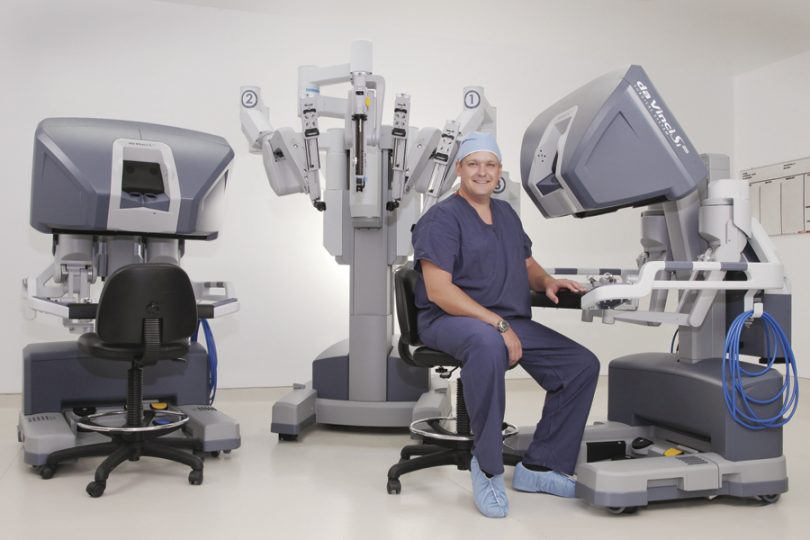Written by Donna C. Gregory
Robots performing surgeries. Electrodes inserted into people’s brains. A device that controls bodily functions.
Sound like the makings of a good sci-fi movie?
These are real-life examples of how science and technology are merging to create better outcomes for patients.
Technology now impacts every stage of patient care, from how we see the doctor to the treatments we receive on the operating-room table.
Coming to a Screen Near You
When it comes to health care, location can mean the difference between the haves and the have-nots. Such is the case for Virginia’s Northern Neck, where patients often have to drive more than an hour to Norfolk or Richmond to receive specialized care.
Unfortunately, not all patients have the time to make the trip. Conditions like a stroke require immediate attention, and that’s why Riverside Tappahannock Hospital has started a new telemedicine program to get patients the help they need as quickly as possible.
“A lot of smaller and rural hospitals don’t have neurologists,” says Dr. James Dudley, the hospital’s service line chief and an emergency room physician. “This is a way for us to bring that expertise to a rural area.”
Patients admitted to the emergency room with stroke-like symptoms are evaluated by a neurologist in Newport News using real-time, high-resolution video conferencing. The consulting neurologist is able to visually check the patient for facial weakness, speech problems, balance and other tell-tale signs of stroke.
“Once he does the assessment, he gives us instructions on what to do,” Dudley says. “We initiate the treatment right there, and then we transfer the patient to the regional
medical center.”
Launched in November 2011, the hospital’s program is still relatively new, so its success rate is unknown.
“Other centers that have similar programs have shown clear benefits to patients,” Dudley says. “We don’t have enough data yet, but we wouldn’t do it if the evidence didn’t support it.”
The Commonwealth of Virginia also is taking advantage of telemedicine’s benefits. VCU Medical Center provides medical care via telemedicine to inmates in Virginia’s correctional facilities.
During the fiscal year that ended on June 30, 2011, VCU performed 2,883 telemedicine encounters with inmates, mostly to treat infectious diseases and chronic cardiology issues.
Telemedicine saves the state millions each year by eliminating the cost of having to transport inmates to the medical center.
Mr. Roboto Invades the OR
Dr. Zvonko Spasic made history in the operating room at St. Mary’s Hospital in Richmond last November, but he didn’t do it alone. Spasic performed the first hysterectomy combining a laser with the da Vinci Surgical System on the East Coast.
The laser is just one of many attachments that can be used with the da Vinci. The first da Vinci robot debuted in 1999. Subsequent generations of the machine are now used to perform minimally invasive surgery for a range of conditions, including cancer, coronary artery disease, endometriosis, kidney disorders and others.
“The laser [attachment] is very, very precise,” Spasic says. “The blood loss is minimal.”
It’s so precise, in fact, that it required only four small incisions, about 8 mm each, compared to traditional hysterectomies that involve surgeons making a 6- to 12-inch incision across the belly.
The result is smaller scars and a faster recovery time for patients.
Spasic says the combination of using a laser in tandem with the da Vinci robot has many uses beyond gynecology. In urology, it can be used during prostate surgery, while ear nose and throat surgeons use it to remove growths from the vocal cords.
Every generation of the da Vinci system becomes more futuristic. The latest version, the da Vinci Si, includes 3D HD visualization with up to 10x magnification.
Dr. Marc Katz, chief medical officer of Bon Secours Heart and Vascular Institute, uses the da Vinci robot to repair mitral valves in the heart.
Standard heart surgery requires the surgeon to cut the patient’s breastbone. “It’s great because we can get both hands around the heart and get access to everything,” Katz says. “But it’s not great for patients. They’re out of business for three months, and they can’t do any heavy activities.
“Da Vinci allows us to now operate through these little incisions to accomplish what we were doing through traditional surgery,” Katz continues. “I’m able to do very precise repairs to these valves. Plus, the patients are able to get out of the hospital in an average of two days. I had one patient who, 10 days after surgery, walked six miles. To me, the fact that they’re able to do these things, it’s remarkable.”
Dr. Dipin Gupta, with Cardiothoracic Surgical Associates in Richmond, uses the da Vinci robot to remove lung cancer.
“Robotic technology is definitely here to stay,” Gupta says. “It’s really a game changer.”
Plans are currently under way to develop a da
Vinci system that will require only one incision for certain surgeries.
It Is Brain Surgery
Brain surgery is getting a lot smarter, thanks to technology.
At CJW Medical Center’s Johnston-Willis Hospital in Chesterfield County, Drs. K. Singh Sahni and Matthew Boyce are teaming up to relieve essential tremors in patients with Parkinson’s disease. The procedure, known as deep brain stimulation, involves placing electrodes in the brain’s thalamus using the StealthStation S7, a surgical navigation system developed by Medtronic. The tremors stop when the electrodes are stimulated with an electrical pulse, controlled externally with a special device similar to a remote control.
“If you think of a pacemaker and what it does for the heart, this does the same for the brain,” Sahni says. “Some of them can’t even walk if this [device] is [turned] off.”
At Riverside Health System, Dr. Dean Kostov uses the peninsula’s only biplane machine to image and treat vascular diseases of the head and neck, such as cancer tumors, stroke and carotid artery disease.
The machine is particularly useful in the treatment of aneurysms. Kostov inserts a catheter into the femoral artery in the groin up to the brain aneurysm. Platinum coils are then placed into the aneurysm, effectively stopping the blood flow.
Medical Records at the Click of a Button
Years ago, patient health records were stored in manila folders, filed away alphabetically in the storage rooms of physicians’ offices. Advances in computer technology have allowed many physicians’ offices to downsize their archives to a computer.
Now, Virginia is encouraging physicians to share those electronic medical records through the creation of a Health Information Exchange (HIE).
The Virginia Department of Health awarded a contract to the nonprofit Community Health Alliance to create and govern the HIE. The system should be operational by late this year. Once online, physicians will be able to access medical records nationwide after a patient has opted into the program. Physicians will pay a fee (at press time the amount was undecided) to participate in the HIE.
“It provides the ability to access electronic patient information once the patient has opted in,” says Debbie Secor, director/chief information officer of the Virginia Department of Health’s Office of Information Management. “You would go to your doctor’s office … and would be given information on whether you want to be able to access your information or have other doctors access your information electronically. There are lots of benefits to the HIE. The overall outcome we’re looking for is enhanced health care.”
Some systems, like Riverside, already have been using EMRs for years. Riverside began with individual servers at physicians’ offices in 1996, and now has a full EMR network across its system of hospitals and medical groups.
“All the physicians who see you contribute to that record,” explains Dr. Charles Frazier, a family physician and Riverside’s vice president of clinical innovation. “In the relatively near future, we’ll have some of the same kind of opportunities with other health care providers in the area, the state and ultimately, the nation.”
Time-saving is one of the biggest advantages of EMRs. In emergency situations, the ability to access patients’ EMRs could save lives because the records provide valuable data, such as drug allergies, which enable physicians to make the best decisions regarding care.
EMRs also further day-to-day care. About a year ago, Frazier had a patient experiencing nonspecific neurological symptoms. He ordered a magnetic resonance angiogram, a test that images the body’s blood vessels. Frazier was out of town on the day of the test, but was able to log into the EMR system to view the results. He referred the patient to a neurosurgery partner, sending the patients’ record electronically to the specialist.
“All of my notes, X-rays, were in there,” says Frazier.
He then enjoyed a long weekend off. By Monday, when Frazier returned to the office, the patient had already been seen by the specialist.
Other benefits include reducing errors on medical records because of illegible handwriting and improving communication with patients.
The VCU Department of Family Medicine has developed a portal, MyPreventativeCare, to encourage patients to become more engaged in their health care.
“It cracks open the doctor’s record, explains it in lay language and tells them this is what you need to do to improve your health and well-being,” says Dr. Alex Krist, associate professor of the VCU Department of Family Medicine.
MyPreventativeCare isn’t technically an EMR—it’s more of an educational tool for patients. For example, if a patient has a family history of colon cancer, it will provide screening information. “Then it gives them a set of resources to help them,” says Krist. “Those resources are very individualized for each patient’s profile.”
A study funded by the Agency for Health Research and Quality found the portal increased preventative services by 12 percent, to 16 percent.
Fourteen practices in Richmond, Fairfax, Newport News and Front Royal, including 18,000 patients, use the portal. “That number grows by 400 a week right now,” says Krist.
The department is applying for a $3.5 million grant from the National Cancer Institute to provide access to the portal to disadvantaged populations in eight states. A decision on the grant will come next summer.
“The idea is to make health information systems more patient-centered and more accessible to patients,” Krist says.
 Dr. John E. Barrett, CEO of Bon Secours DePaul Medical Center in Norfolk, sits with the da Vinci® SiTM surgical system, the latest in a series of investments that Bon Secours has made at DePaul Medical Center. The new $2.5 million robotic surgical system provides surgeons access to the latest advancements in minimally invasive surgery and can be used in a multitude of procedures including, but not limited to: prostatectomy, hysterectomy, myomectomy, coronary artery bypass, thoracic surgery, mitral valve repair and colorectal surgery.
Dr. John E. Barrett, CEO of Bon Secours DePaul Medical Center in Norfolk, sits with the da Vinci® SiTM surgical system, the latest in a series of investments that Bon Secours has made at DePaul Medical Center. The new $2.5 million robotic surgical system provides surgeons access to the latest advancements in minimally invasive surgery and can be used in a multitude of procedures including, but not limited to: prostatectomy, hysterectomy, myomectomy, coronary artery bypass, thoracic surgery, mitral valve repair and colorectal surgery.

